会议论文模板
- 格式:doc
- 大小:106.50 KB
- 文档页数:6
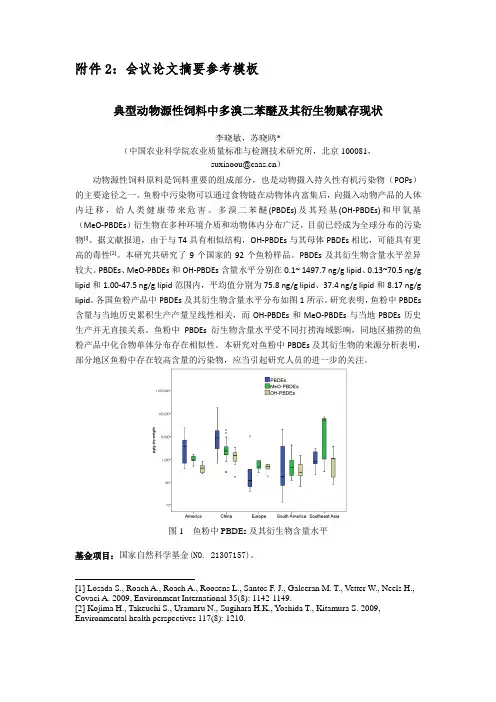
附件2:会议论文摘要参考模板典型动物源性饲料中多溴二苯醚及其衍生物赋存现状李晓敏,苏晓鸥*(中国农业科学院农业质量标准与检测技术研究所,北京100081,suxiaoou@)动物源性饲料原料是饲料重要的组成部分,也是动物摄入持久性有机污染物(POPs)的主要途径之一。
鱼粉中污染物可以通过食物链在动物体内富集后,向摄入动物产品的人体内迁移,给人类健康带来危害。
多溴二苯醚(PBDEs)及其羟基(OH-PBDEs)和甲氧基(MeO-PBDEs)衍生物在多种环境介质和动物体内分布广泛,目前已经成为全球分布的污染物[i]。
据文献报道,由于与T4具有相似结构,OH-PBDEs与其母体PBDEs相比,可能具有更高的毒性[2]。
本研究共研究了9个国家的92个鱼粉样品。
PBDEs及其衍生物含量水平差异较大。
PBDEs、MeO-PBDEs和OH-PBDEs含量水平分别在0.1~ 1497.7 ng/g lipid、0.13~70.5 ng/g lipid和1.00-47.5 ng/g lipid范围内,平均值分别为75.8 ng/g lipid、37.4 ng/g lipid和8.17 ng/g lipid。
各国鱼粉产品中PBDEs及其衍生物含量水平分布如图1所示。
研究表明,鱼粉中PBDEs 含量与当地历史累积生产产量呈线性相关,而OH-PBDEs和MeO-PBDEs与当地PBDEs历史生产并无直接关系。
鱼粉中PBDEs衍生物含量水平受不同打捞海域影响,同地区捕捞的鱼粉产品中化合物单体分布存在相似性。
本研究对鱼粉中PBDEs及其衍生物的来源分析表明,部分地区鱼粉中存在较高含量的污染物,应当引起研究人员的进一步的关注。
图1 鱼粉中PBDEs及其衍生物含量水平基金项目:国家自然科学基金(NO. 21307157)。
[1] Losada S., Roach A., Roach A., Roosens L., Santos F. J., Galceran M. T., Vetter W., Neels H., Covaci A. 2009, Environment International 35(8): 1142-1149.[2] Kojima H., Takeuchi S., Uramaru N., Sugihara H.K., Yoshida T., Kitamura S. 2009, Environmental health perspectives 117(8): 1210.。
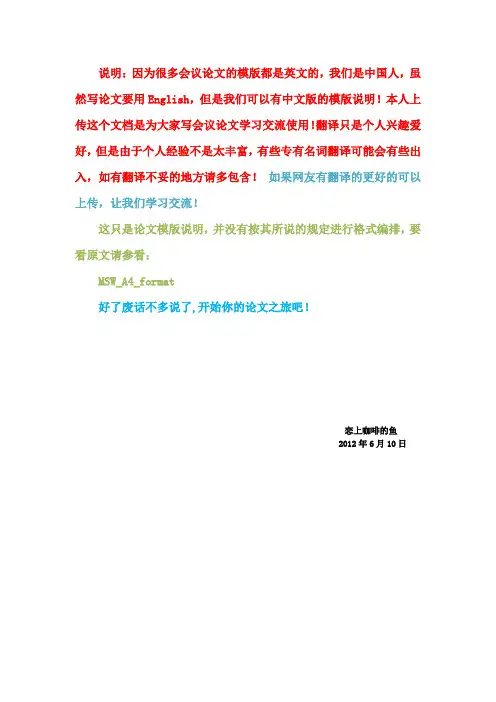
说明:因为很多会议论文的模版都是英文的,我们是中国人,虽然写论文要用English,但是我们可以有中文版的模版说明!本人上传这个文档是为大家写会议论文学习交流使用!翻译只是个人兴趣爱好,但是由于个人经验不是太丰富,有些专有名词翻译可能会有些出入,如有翻译不妥的地方请多包含!如果网友有翻译的更好的可以上传,让我们学习交流!这只是论文模版说明,并没有按其所说的规定进行格式编排,要看原文请参看:MSW_A4_format好了废话不多说了,开始你的论文之旅吧!恋上咖啡的鱼 2012年6月10日论文题目(使用样式:论文题目)副标题根据需要(论文副标题)第一从属作者姓名第二从属作者姓名第一行(从属关系):部门.组织机构名称第一行(从属关系):部门.组织机构名称第二行:组织机构名称,可以接受首字母缩写第二行:组织机构名称,可以接受首字母缩写第三行:城市,国家第三行:城市,国家第四行:电子邮箱如需要的话第四行:电子邮箱如需要的话摘要—这个电子文件是“排好版的”模版。
你论文的各种不同的组成部分[论文标题,正文,段落标题等]已经在这样式表中定义了,如文件中部分给出的举例说明。
(摘要)关键词-组件;格式化;类型;式样;插入(关键词)1.介绍(标题1)这个模版,对于个人电脑在MS Word 2003中修改以及保存为“Word 97-2003&6.0/95-RTF”,为作者提供了大部分他们论文需要准备的电子版本的格式规范。
所有标准论文组件被指定因为三个原因:(1)当格式化个人的论文时操作简单,(2)自动符合电子需求,以促进并发或后续生产的电子产品,(3)会议论文集从头到尾风格一致。
页边距,列宽度,行间距和字样是内置的;在文件中提供了字样的示例以及用斜体字类型辨识出,在圆括号中,在示例的后面。
一些组件,例如多层次公式,图形和表格没有指定,尽管提供了各种表文本样式。
格式化程序将需要创建这些组件,包含了适用的后续标准。
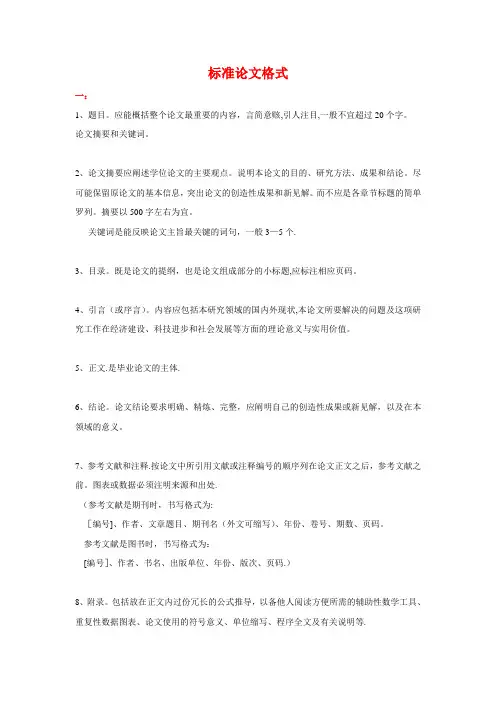
标准论文格式一:1、题目。
应能概括整个论文最重要的内容,言简意赅,引人注目,一般不宜超过20个字。
论文摘要和关键词。
2、论文摘要应阐述学位论文的主要观点。
说明本论文的目的、研究方法、成果和结论。
尽可能保留原论文的基本信息,突出论文的创造性成果和新见解。
而不应是各章节标题的简单罗列。
摘要以500字左右为宜。
关键词是能反映论文主旨最关键的词句,一般3—5个.3、目录。
既是论文的提纲,也是论文组成部分的小标题,应标注相应页码。
4、引言(或序言)。
内容应包括本研究领域的国内外现状,本论文所要解决的问题及这项研究工作在经济建设、科技进步和社会发展等方面的理论意义与实用价值。
5、正文.是毕业论文的主体.6、结论。
论文结论要求明确、精炼、完整,应阐明自己的创造性成果或新见解,以及在本领域的意义。
7、参考文献和注释.按论文中所引用文献或注释编号的顺序列在论文正文之后,参考文献之前。
图表或数据必须注明来源和出处.(参考文献是期刊时,书写格式为:[编号]、作者、文章题目、期刊名(外文可缩写)、年份、卷号、期数、页码。
参考文献是图书时,书写格式为:[编号]、作者、书名、出版单位、年份、版次、页码.)8、附录。
包括放在正文内过份冗长的公式推导,以备他人阅读方便所需的辅助性数学工具、重复性数据图表、论文使用的符号意义、单位缩写、程序全文及有关说明等.二:本科毕业论文格式要求:1、装订顺序:目录—-内容提要-—正文-—参考文献——写作过程情况表—-指导教师评议表参考文献应另起一页。
纸张型号:A4纸。
A4 210×297毫米论文份数:一式三份。
其他(调查报告、学习心得):一律要求打印.2、论文的封面由学校统一提供。
(或听老师的安排)3、论文格式的字体:各类标题(包括“参考文献”标题)用粗宋体;作者姓名、指导教师姓名、摘要、关键词、图表名、参考文献内容用楷体;正文、图表、页眉、页脚中的文字用宋体;英文用Times New Roman字体。
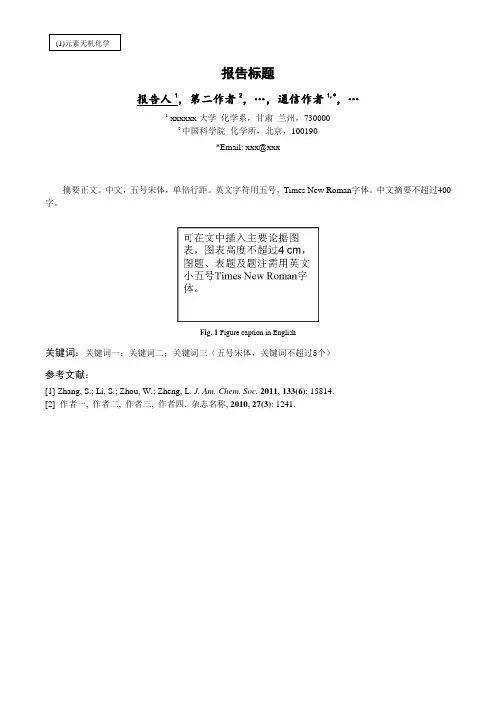
(1)元素无机化学报告标题报告人1,第二作者2,…,通信作者1,*,…1xxxxxx大学化学系,甘肃兰州,7300002中国科学院化学所,北京,100190*Email: xxx@xxx摘要正文。
中文,五号宋体,单倍行距。
英文字符用五号,Times New Roman字体。
中文摘要不超过400字。
Fig. 1 Figure caption in English关键词:关键词一;关键词二;关键词三(五号宋体,关键词不超过5个)参考文献:[1] Zhang, S.; Li, S.; Zhou, W.; Zheng, L. J. Am. Chem. Soc.2011, 133(6): 15814.[2] 作者一, 作者二, 作者三, 作者四. 杂志名称, 2010, 27(3): 1241.(1)元素无机化学TitleAuthor (San Zhang)1, Second Author(Si Li) 2, Corresponding Author(Wu Zhou)1,*1Department of Chemistry, University of xxxxxx, City, Post code2Institute of Chemistry, Chinese Academy of Sciences, City, Post code*Email: xxx@xxxAbstract, Times New Roman, single spaced, 450 words in maximum.Fig. 1 Figure captionKeywords: Times New Roman, 5 keywords in maximumReference:[1] Zhang, S.; Li, S.; Zhou, W.; Zheng, L. J. Am. Chem. Soc.2011, 133(6): 15814.[2] Zhang, S.; Li, S.; Zhou, W.; Zheng, L. J. Phys. Chem. B2012, 21(3): 1356.中国化学会第九届全国无机化学学术会议论文摘要撰写说明1. 页面设置纸张A4,页边距上下边距2.54cm,左右边距1.91cm;2. 请使用论文模板,在相应位置填写论文内容,并删除提示内容;3. 论文摘要全部内容不超过一页纸;4. 请务必在论文左上角注明征文范围的领域编号;5. 论文撰写完成后,保存为Word97-2003文档提交。

ieee会议论文格式【篇一:sci、ieee会议论文模板】paper title* (use style: paper title)subtitle as needed (paper subtitle)authors name/s per 1st affiliation (author)line 1 (of affiliation): dept. name of organization line 2-name of organization, acronyms acceptableline 3-city, countryline 4-e-mail address if desiredauthors name/s per 2nd affiliation (author)line 1 (of affiliation): dept. name of organization line 2-name of organization, acronyms acceptableline 3-city, country line 4-e-mail address if desiredabstract—this electronic document is a “live” template and already defines the components of your paper [title, text, heads, etc.] in its style sheet. *critical: do not use symbols, special characters, or math in paper title or abstract. (abstract) keywords—component; formatting; style; styling; insert (key words)i. introduction (heading 1)“word 97this template, modified in ms word 2007 and saved as a -2003 document” for the pc, provides authors with most of the formatting specifications needed for preparing electronic versions of their papers. all standard paper components have been specified for three reasons: (1) ease of use when formatting individual papers, (2) automatic compliance to electronic requirements that facilitate the concurrent or later production of electronic products, and (3) conformity of style throughout a conference proceedings. margins, column widths, line spacing, and type styles are built-in; examples of the type styles are provided throughout this document and are identified in italic type, within parentheses, following the example. some components, such as multi-leveled equations, graphics, and tables are not prescribed, although the various table text styles are provided. the formatter will need to create these components, incorporating the applicable criteria that follow.ii. ease of usea. selecting a template (heading 2)first, confirm that you have the correct template for your paper size. this template has been tailored for output on the a4 paper size. if you are using us letter-sized paper, please close thisfile and download the file “msw_usltr_format”. b. maintaining the integrity of the specificationsthe template is used to format your paper and style the text. all margins, column widths, line spaces, and text fonts are prescribed; please do not alter them. you may note peculiarities. for example, the head margin in this template measures proportionately more than is customary. this measurement and others are deliberate, using specifications that anticipate your paper as one part of the entire proceedings, identify applicable sponsor/s here. if no sponsors, delete this text box (sponsors).and not as an independent document. please do not revise any of the current designations.iii. prepare your paper before stylingbefore you begin to format your paper, first write and save the content as a separate text file. keep your text and graphic files separate until after the text has been formatted and styled. do not use hard tabs, and limit use of hard returns to only one return at the end of a paragraph. do not add any kind of pagination anywhere in the paper. do not number text heads-the template will do that for you.finally, complete content and organizational editing before formatting. please take note of the following items when proofreading spelling and grammar:a. abbreviations and acronymsdefine abbreviations and acronyms the first time they are used in the text, even after they have been defined in the abstract. abbreviations such as ieee, si, mks, cgs, sc, dc, and rms donot have to be defined. do not use abbreviations in the title or heads unless they are unavoidable.b. units? use either si (mks) or cgs as primary units. (si units are encouraged.) english units may be used as secondary units (in parentheses). an exception would be the use of english units as identifiers in trade, such as “3.5-inch disk drive.” ? avoid combining si and cgs units, such as current in amperes andmagnetic field in oersteds. this often leads to confusion because equations do not balance dimensionally. if you must use mixed units, clearly state the units for each quantity that you use in an equation. ? do not mix complete spellings and abbreviations of units: “webers/m2.“wb/m2” spell units when they appear in text: ” or “webers per square meter,” “not ...a few heies,” not “...a few h.” ? use a zero before decimal points: “0.25,” not “.25.” use “cm3,”not “cc.” (bullet list)c. equationsthe equations are an exception to the prescribed specifications of this template. you will need to determine whether or not your equation should be typed using either the times new roman or the symbol font (please no other font). to create multileveled equations, it may be necessary to treat the equation as a graphic and insert it into the text after your paper is styled.number equations consecutively. equation numbers, within parentheses, are to position flush right, as in (1), using a right tab stop. to make your equations more compact, you may use the solidus ( / ), the exp function, or appropriate exponents. italicize roman symbols for quantities and variables, but not greek symbols. use a long dash rather than a hyphen for a minus sign. punctuate equations with commas or periods when they are part of a sentence, as in ?a???b??????????note that the equation is centered using a center tab stop. be sure that the symbols in your equation have been defined befor e or immediately following “eq. (1)” or “equation (1),” except the equation. use at the beginning “(1),”of not a sentence: “equation (1) is ...”d. some common mistakes? the word “data” is plural, not singular.? the subscript for the permeability of vacuum ?other common scientific constants, is zero 0, and with subscript formatting, not a lowercase letter “o.” ? in american english, commas, semi-/colons, periods, question and exclamation marks are located within quotation marks only when a complete thought or name is cited, such as a title or full quotation. when quotation marks are used, instead of a bold oritalic typeface, to highlight a word or phrase, punctuation should appear outside of the quotation marks. a parenthetical phrase or statement at the end of a sentence is punctuated outside of the closing parenthesis (like this). (a parenthetical sentence is punctuated within the parentheses.) ? a graph within a graph is an “inset,” not an “insert.” the “alternatelyword ”alternatively (unless you i s really preferred mean something to the word that alternates). ? do “approximatelynot use ” or the “effectively.word “essentially” ” to mean ? in your paper title, if the words “that uses” can accurately replace the word using, capitalize the “u”; if not, keep using lower-cased. ? be aware of the different meaningsof the homophones “affect” and “effect,” “complement” and “compliment,” “discreet” and “discrete,” “principal” and “principle.”? do not confuse “imply” and “infer.”? the prefix “non” is not a word; it should be joined to theword it modifies, usually without a hyphen. ? there is no period after the “et” in the latin abbreviation “et al.” ? the abbreviation “i.e.” means “that is,” and the abbreviation “e.g.” means “for example.” an excellent s tyle manual for science writers is [7].iv. using the templateafter the text edit has been completed, the paper is ready for the template. duplicate the template file by using the save as command, and use the naming convention prescribed by your conference for the name of your paper. in this newly created file, highlight all of the contents and import your prepared text file. you are now ready to style your paper; use the ?scroll down ?????????????window on ????the left ????of the ms word formatting toolbar.a. authors and affiliationsthe template is designed so that author affiliations are not repeated each time for multiple authors of the same affiliation. please keep your affiliations as succinct as possible (for example, do not differentiate among departments of the same organization). this template was designed for two affiliations. 1) for author/s of only one affiliation (heading 3): to change the default, adjust the template as follows.a) selection (heading 4): highlight all author and affiliation lines.b) change number of columns: select the columns icon from the ms word standard toolbar and then select “1 column” from the selection palette.c) deletion: delete the author and affiliation lines for the second affiliation.2) for author/s of more than two affiliations: to change the default, adjust the template as follows.a) selection: highlight all author and affiliation lines. b) change number of columns: select the “columns” icon from the ms word standard toolbar and t hen select “1 column” from the selection palette.c) highlight author and affiliation lines of affiliation 1 and copy this selection.d) formatting: insert one hard return immediately after the last character of the last affiliation line. then paste down the copy of affiliation 1. repeat as necessary for each additional affiliation.e) reassign number of columns: place your cursor to the right of the last character of the last affiliation line of an even numbered affiliation (e.g., if there are five affiliations, place your cursor at end of fourth affiliation). drag the cursor up to highlight all of the above author and affiliation lines. go to column icon and select “2 columns”. if you have an oddnumber of affiliations, the final affiliation will be centered on the page; all previous will be in two columns.b. identify the headingsheadings, or heads, are organizational devices that guide the reader through your paper. there are two types: component heads and text heads.component heads identify the different components of your paper and are not topically subordinate to each other. examples include acknowledgments and references, “heading 5.” use and “figure for these, captionthe ” for correct your figure style to caption s, use is and “abstract,“table ” will require you to apply a style (in this case, italic) head” for your table title. run-in heads, such as in addition to the style provided by the drop down menu to differentiate the head from the text.text heads organize the topics on a relational, hierarchical basis. for example, the paper title is the primary text headbecause all subsequent material relates and elaborates on this one topic. if there are two or more sub-topics, the next level head (uppercase roman numerals) should be used and, conversely, if there are not at least two sub-topics, then no subheads “heading 2,should ” “heading 3,be introduced. ” and “heading 4styles named ” are prescribed. “heading 1,” c. figures and tables1) positioning figures and tables: place figures and tables at the top and bottom of columns. avoid placing them in the middle of columns. large figures and tables may span across both columns. figure captions should be below the figures; table heads should appear above the tables. insert figures and tables after they are cited in the text. use the abbreviation “fig. 1,” even at the beginning of a sentence.table i.table stylessample of a table footnote. (table footnote)b.fig. 1. example of a figure caption. (figure caption)figure labels: use 8 point times new roman for figure labels. use words rather than symbols or abbreviations when writing figure axis labels to avoid confusing the reader. as an example, “magnetization, write m,” the not just quantity “m.” if “including magnetization,units ”in the or label, present them within parentheses. do not label axes only with “magnetization (a ( m(1),units. in the example, ” not just write “magnetization “a/m.” do not label axes (a/m)” or with “temperature (k),a ratio of quantities ” not “temperature/k.and units. ”forexample, write acknowledgment (heading 5)the preferred spelling of the word “acknowledgment” in america is without an “e” after the “g.” avoid the stilted expression “one of us (r. b. g.) thanks ...”. instead, try “r. b. g. thanks...”. put sponsor acknowledgments in the unnumbered footnote on the first page.referencesthe template will number citations consecutively within brackets [1]. the sentence punctuation follows the bracket [2]. refer “ref. simply [3]” or to “reference the reference [3]” number, except at as the in [3]beginning —do not of use a sentence: “reference [3] was the first ...”number footnotes separately in superscripts. place the actual footnote at the bottom of the column in which it was cited. do not put footnotes in the reference list. use letters for table footnotes.unless there are six authors or more give all authors’ names; do not use “et al.”. papers that have not been published, even if they have been submitted for publication, should be cited as “unpublished” [4]. papers that have been accepted for publication should be cited as “in press” [5]. capitalize only the first word in a paper title, except for proper nouns and element symbols.for papers published in translation journals, please give the english citation first, followed by the original foreign-language citation [6].[1] g. eason, b. noble, and i.n. sneddon, “on certain integrals oflipschitz-hankel type involving products of bessel functions,” phil. trans. roy. soc. london, vol. a247, pp. 529-551, april 1955. (references)[2] j. clerk maxwell, a treatise on electricity and magnetism,3rd ed., vol.2. oxford: clarendon, 1892, pp.68-73.[3] i.s. jacobs and c.p. bean, “fine particles, thin films and exchangeanisotropy,” in magnetism, vol. iii, g.t. rado and h. suhl, eds. new york: academic, 1963, pp. 271-350.[4] k. elissa, “title of paper if known,” unpublished.[5] r. nicole, “title of paper with only first word capitalized,” j. namestand. abbrev., in press.[6] y. yorozu, m. hirano, k. oka, and y. tagawa, “electron spectroscopystudies on magneto-optical media and plastic substrate interface,” ieee transl. j. magn. japan, vol. 2, pp. 740-741, august 1987 [digests 9th annual conf. magnetics japan, p. 301, 1982].[7] m. young, the technical writer’s handbook. mill valley, ca: university science, 1989.【篇二:国际会议论文格式(中文)】论文题目(格式:论文题目格式)副标题(如果有的话用“副标题”格式)第一作者姓名第二作者姓名第一行:部门名称第一行部门名称第二行:组织名称,缩写词第二行:组织名称,缩写词第三行:城市,国家第三行:城市,国家第四行:电子邮件(若有要求的话)摘要—本电子文档是一个“活”的模板,论文的各个组成部分(题目,正文,标题等)已经在样式表中定义,在本文档也给出了阐明。
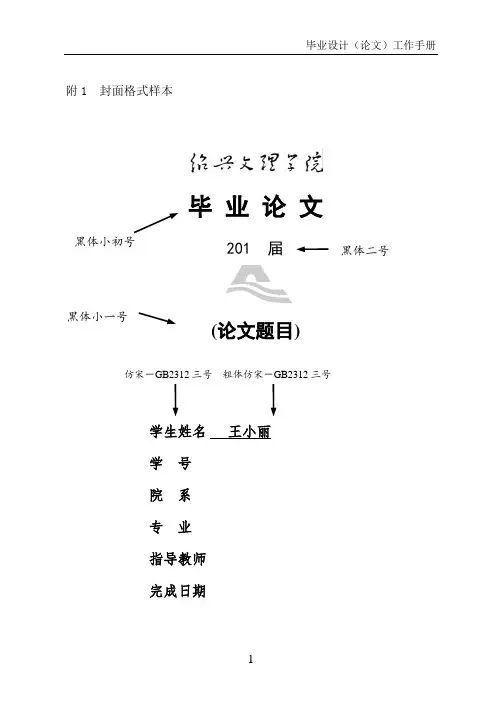
附1 封面格式样本(论文题目)仿宋-GB2312 三号 粗体仿宋-GB2312 三号黑体小一号 201 届 毕 业 论 文 黑体小初号 学生姓名 王小丽学 号院 系专 业指导教师完成日期黑体二号附2 中文题目、摘要及关键词格式样本(另起一页)自动化立体仓库堆垛机的设计摘 要,现代企业生产规模的不断扩大和竞争的日益加剧,市场对企业物流系统提出了新的要求,自动化立体仓库越来越受到关注并得到广泛应用。
堆垛机是立体仓库中关键的起重、搬运设备,本文介绍了有轨巷道式双立柱堆垛机的结构和特点,并对它的设计要点进行了分析和讨论。
关键词 自动化立体仓库;堆垛机;设计 四号黑体居中空二行 小四宋体空一行空一行附3 英文题目、摘要及关键词格式样本(另起一页)DESIGN OF STACKING ABOUTAUTOMATED HIGH-RISE WAREHOUSEABSTRACTWith the development of computer information technology ,increasingly expanding of modern enterprise production scale and more and more fierce market competition ,new requirements of enterprise logistics by market are emerging ,and automated high —rise warehouses gains more attention and have been used widely ,SRM is the most important conveying and lifting equipment in automated high-rise warehouse 。
This paper presents structure ,feature and design of the rail —mounted aisle type double —mast stacking crane 。
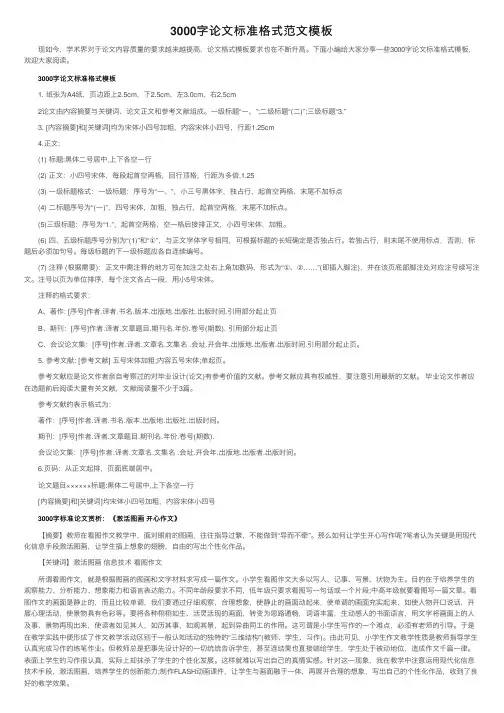
3000字论⽂标准格式范⽂模板 现如今,学术界对于论⽂内容质量的要求越来越提⾼,论⽂格式模板要求也在不断升⾼。
下⾯⼩编给⼤家分享⼀些3000字论⽂标准格式模板,欢迎⼤家阅读。
3000字论⽂标准格式模板1. 纸张为A4纸,页边距上2.5cm,下2.5cm,左3.0cm,右2.5cm 2论⽂由内容摘要与关键词、论⽂正⽂和参考⽂献组成。
⼀级标题“⼀、”;⼆级标题“(⼆)”;三级标题“3.” 3. [内容摘要]和[关键词]均为宋体⼩四号加粗,内容宋体⼩四号,⾏距1.25cm 4.正⽂: (1) 标题:⿊体⼆号居中,上下各空⼀⾏ (2) 正⽂:⼩四号宋体,每段起⾸空两格,回⾏顶格,⾏距为多倍,1.25 (3) ⼀级标题格式:⼀级标题:序号为“⼀、”,⼩三号⿊体字,独占⾏,起⾸空两格,末尾不加标点 (4) ⼆标题序号为“(⼀)”,四号宋体,加粗,独占⾏,起⾸空两格,末尾不加标点。
(5)三级标题:序号为“1.”,起⾸空两格,空⼀格后接排正⽂,⼩四号宋体,加粗。
(6) 四、五级标题序号分别为“(1)”和“①”,与正⽂字体字号相同,可根据标题的长短确定是否独占⾏。
若独占⾏,则末尾不使⽤标点,否则,标题后必须加句号。
每级标题的下⼀级标题应各⾃连续编号。
(7) 注释 (根据需要):正⽂中需注释的地⽅可在加注之处右上⾓加数码,形式为“①、②……”(即插⼊脚注),并在该页底部脚注处对应注号续写注⽂。
注号以页为单位排序,每个注⽂各占⼀段,⽤⼩5号宋体。
注释的格式要求: A、著作: [序号]作者.译者.书名.版本.出版地.出版社.出版时间.引⽤部分起⽌页 B、期刊:[序号]作者.译者.⽂章题⽬.期刊名.年份.卷号(期数). 引⽤部分起⽌页 C、会议论⽂集:[序号]作者.译者.⽂章名.⽂集名 .会址.开会年.出版地.出版者.出版时间.引⽤部分起⽌页。
5. 参考⽂献: [参考⽂献] 五号宋体加粗;内容五号宋体;单起页。
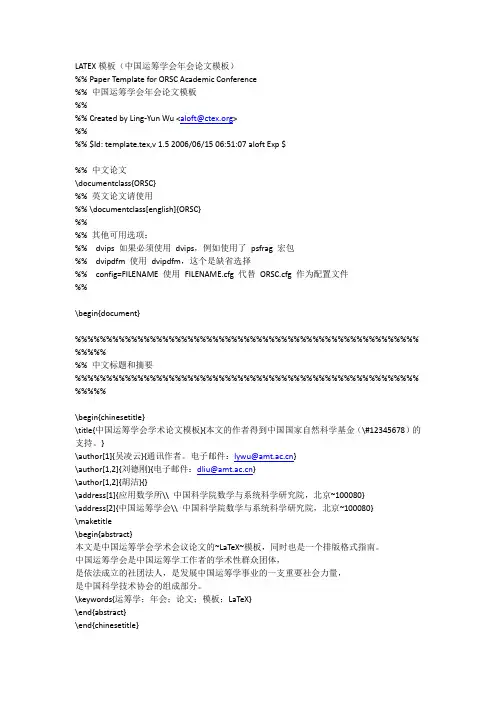
LATEX模板(中国运筹学会年会论文模板)%% Paper Template for ORSC Academic Conference%% 中国运筹学会年会论文模板%%%% Created by Ling-Yun Wu <aloft@>%%%% $Id: template.tex,v 1.5 2006/06/15 06:51:07 aloft Exp $%% 中文论文\documentclass{ORSC}%% 英文论文请使用%% \documentclass[english]{ORSC}%%%% 其他可用选项:%% dvips如果必须使用dvips,例如使用了psfrag宏包%% dvipdfm使用dvipdfm,这个是缺省选择%% config=FILENAME 使用FILENAME.cfg代替ORSC.cfg作为配置文件%%\begin{document}%%%%%%%%%%%%%%%%%%%%%%%%%%%%%%%%%%%%%%%%%%%%%%%%%%%%%%% %%%%%%% 中文标题和摘要%%%%%%%%%%%%%%%%%%%%%%%%%%%%%%%%%%%%%%%%%%%%%%%%%%%%%%% %%%%%\begin{chinesetitle}\title{中国运筹学会学术论文模板}{本文的作者得到中国国家自然科学基金(\#12345678)的支持。
}\author[1]{吴凌云}{通讯作者。
电子邮件:lywu@}\author[1,2]{刘德刚}{电子邮件:dliu@}\author[1,2]{胡洁}{}\address[1]{应用数学所\\ 中国科学院数学与系统科学研究院,北京~100080}\address[2]{中国运筹学会\\ 中国科学院数学与系统科学研究院,北京~100080}\maketitle\begin{abstract}本文是中国运筹学会学术会议论文的~LaTeX~模板,同时也是一个排版格式指南。
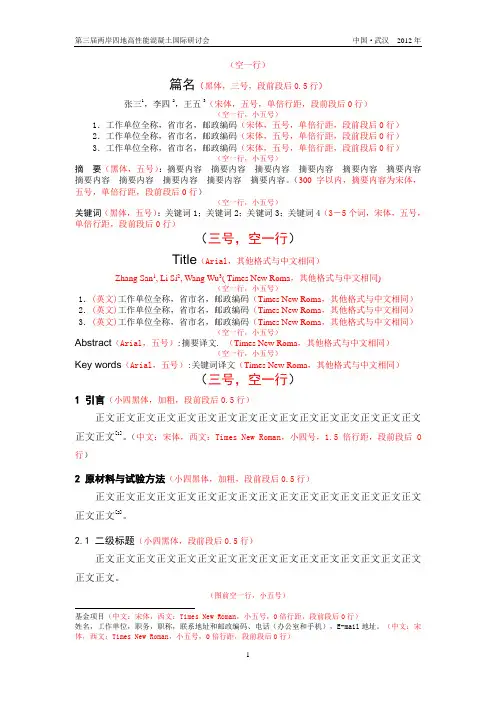
(空一行)篇名(黑体,三号,段前段后0.5行)张三1,李四2,王五3(宋体,五号,单倍行距,段前段后0行)(空一行,小五号)1.工作单位全称,省市名,邮政编码(宋体,五号,单倍行距,段前段后0行)2.工作单位全称,省市名,邮政编码(宋体,五号,单倍行距,段前段后0行)3.工作单位全称,省市名,邮政编码(宋体,五号,单倍行距,段前段后0行)(空一行,小五号)摘要(黑体,五号):摘要内容摘要内容摘要内容摘要内容摘要内容摘要内容摘要内容摘要内容摘要内容摘要内容摘要内容。
(300字以内,摘要内容为宋体,五号,单倍行距,段前段后0行)(空一行,小五号)关键词(黑体,五号):关键词1;关键词2;关键词3;关键词4(3-5个词,宋体,五号,单倍行距,段前段后0行)(三号,空一行)Title(Arial,其他格式与中文相同)Zhang San1, Li Si2, Wang Wu3( Times New Roma,其他格式与中文相同)(空一行,小五号)1.(英文)工作单位全称,省市名,邮政编码(Times New Roma,其他格式与中文相同)2.(英文)工作单位全称,省市名,邮政编码(Times New Roma,其他格式与中文相同)3.(英文)工作单位全称,省市名,邮政编码(Times New Roma,其他格式与中文相同)(空一行,小五号)Abstract(Arial,五号):摘要译文.(Times New Roma,其他格式与中文相同)(空一行,小五号)Key words(Arial,五号):关键词译文(Times New Roma,其他格式与中文相同)(三号,空一行)1 引言(小四黑体,加粗,段前段后0.5行)正文正文正文正文正文正文正文正文正文正文正文正文正文正文正文正文正文正文[1]。
(中文:宋体,西文:Times New Roman,小四号,1.5倍行距,段前段后0行)2 原材料与试验方法(小四黑体,加粗,段前段后0.5行)正文正文正文正文正文正文正文正文正文正文正文正文正文正文正文正文正文正文[2]。
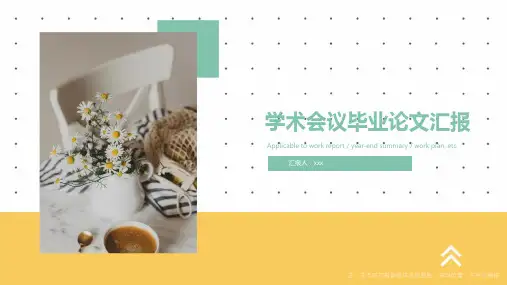
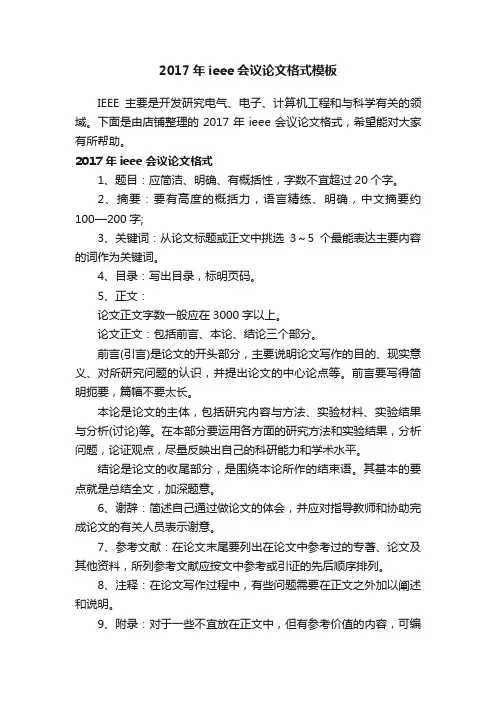
2017年ieee会议论文格式模板IEEE主要是开发研究电气、电子、计算机工程和与科学有关的领域。
下面是由店铺整理的2017年ieee会议论文格式,希望能对大家有所帮助。
2017年ieee会议论文格式1、题目:应简洁、明确、有概括性,字数不宜超过20个字。
2、摘要:要有高度的概括力,语言精练、明确,中文摘要约100—200字;3、关键词:从论文标题或正文中挑选3~5个最能表达主要内容的词作为关键词。
4、目录:写出目录,标明页码。
5、正文:论文正文字数一般应在3000字以上。
论文正文:包括前言、本论、结论三个部分。
前言(引言)是论文的开头部分,主要说明论文写作的目的、现实意义、对所研究问题的认识,并提出论文的中心论点等。
前言要写得简明扼要,篇幅不要太长。
本论是论文的主体,包括研究内容与方法、实验材料、实验结果与分析(讨论)等。
在本部分要运用各方面的研究方法和实验结果,分析问题,论证观点,尽量反映出自己的科研能力和学术水平。
结论是论文的收尾部分,是围绕本论所作的结束语。
其基本的要点就是总结全文,加深题意。
6、谢辞:简述自己通过做论文的体会,并应对指导教师和协助完成论文的有关人员表示谢意。
7、参考文献:在论文末尾要列出在论文中参考过的专著、论文及其他资料,所列参考文献应按文中参考或引证的先后顺序排列。
8、注释:在论文写作过程中,有些问题需要在正文之外加以阐述和说明。
9、附录:对于一些不宜放在正文中,但有参考价值的内容,可编入附录中。
关于ieee的论文范文:《基于IEEE―1394总线的高速数据采集系统设计》摘要:为了实现数据采集系统实时性、通用化、小型化设计,该文提出了一种基于IEEE-1394总线的高速数据采集系统设计和实现方案。
硬件架构上,系统采用IEEE-1394总线专用芯片,实现了数据高速率、高可靠性传输;采用FPGA+DSP的数据处理架构,将数据采集与算法处理分开独立运行;采用FPGA静态局部重构技术,实现了不同子系统的功能配置;采用开关动态切换技术,实现了信号采集的灵活配置和小型化设计。
Paper TitleSubtitle as neededAuthor1 Name1, Author2 Name21. Dept. name of organization, name of organization, acronyms acceptable, City, Country2. Dept. name of organization, name of organization, acronyms acceptable, City, Country1. e-mail address,2. e-mail addressAbstract: This electronic document defines the standard format of the Chinese academic conference pro-ceedings published by the Scientific Research Publishing (SRP). The elements such as the paper title, author, affiliation, abstract, section title, main text, figure, table and references are defined, and this document is for-matted according to the SRP standard, which illustrates all the formats.Keywords: template; format; SRP; academic conference; proceedings标题副标题第一作者1,第二作者21.单位,城市,国家,邮编2.单位,城市,国家,邮编1. E-mail address,2. E-mail address【摘要】本电子文档定义了由Scientific Research Publishing(SRP)出版的各种中文学术会议论文集的标准文章格式。
Paper Title Subtitle as neededAuthors Name/s per 1st Affiliation (Author) line 1 (of Affiliation): dept. name of organization line 2: name of organization, acronyms acceptableline 3: City, Countryline 4: e-mail: name@ Authors Name/s per 2nd Affiliation (Author) line 1 (of Affiliation): dept. name of organization line 2: name of organization, acronyms acceptableline 3: City, Countryline 4: e-mail: name@Abstract—This electronic document is a “live” template. The various components of your paper [title, text, heads, etc.] are already defined on the style sheet, as illustrated by the portions given in this document. DO NOT USE SPECIAL CHARACTERS, SYMBOLS, OR MATH IN YOUR TITLE OR ABSTRACT. (Abstract)Keywords-component; formatting; style; styling; insert (key words)I.I NTRODUCTION (H EADING 1)All manuscripts must be in English. These guidelines include complete descriptions of the fonts, spacing, and related information for producing your proceedings manuscripts. Please follow them and if you have any questions, direct them to the production editor in charge of your proceedings at Conference Publishing Services (CPS): Phone +1 (714) 821-8380 or Fax +1 (714) 761-1784.This template provides authors with most of the formatting specifications needed for preparing electronic versions of their papers. All standard paper components have been specified for three reasons: (1) ease of use when formatting individual papers, (2) automatic compliance to electronic requirements that facilitate the concurrent or later production of electronic products, and (3) conformity of style throughout a conference proceedings. Margins, column widths, line spacing, and type styles are built-in; examples of the type styles are provided throughout this document and are identified in italic type, within parentheses, following the example. PLEASE DO NOT RE-ADJUST THESE MARGINS. Some components, such as multi-leveled equations, graphics, and tables are not prescribed, although the various table text styles are provided. The formatter will need to create these components, incorporating the applicable criteria that follow.II.T YPE S TYLE AND F ONTSWherever Times is specified, Times Roman or Times New Roman may be used. If neither is available on your word processor, please use the font closest in appearance to Times. Avoid using bit-mapped fonts if possible. True-Type 1 or Open Type fonts are preferred. Please embed symbol fonts, as well, for math, etc.III.E ASE OF U SEA.Selecting a Template (Heading 2)First, confirm that you have the correct template for your paper size. This template has been tailored for output on the US-letter paper size. If you are using A4-sized paper, please close this template and download the file for A4 paper format called ―CPS_A4_format‖.B.Maintaining the Integrity of the SpecificationsThe template is used to format your paper and style the text. All margins, column widths, line spaces, and text fonts are prescribed; please do not alter them. You may note peculiarities. For example, the head margin in this template measures proportionately more than is customary. This measurement and others are deliberate, using specifications that anticipate your paper as one part of the entire proceedings, and not as an independent document. Please do not revise any of the current designations.IV.P REPARE Y OUR P APER B EFORE S TYLING Before you begin to format your paper, first write and save the content as a separate text file. Keep your text and graphic files separate until after the text has been formatted and styled. Do not use hard tabs, and limit use of hard returns to only one return at the end of a paragraph. Do not add any kind of pagination anywhere in the paper. Do not number text heads-the template will do that for you.Finally, complete content and organizational editing before formatting. Please take note of the following items when proofreading spelling and grammar:A.Abbreviations and AcronymsDefine abbreviations and acronyms the first time they are used in the text, even after they have been defined in the abstract. Abbreviations such as IEEE, SI, MKS, CGS, sc, dc, and rms do not have to be defined. Do not use abbreviations in the title or heads unless they are unavoidable.B.UnitsUse either SI (MKS) or CGS as primary units. (SI units are encouraged.) English units may be usedas secondary units (in parentheses). An exceptionwould be the use of English units as identifiers intrade, such as ―3.5-inch disk drive‖.∙Avoid combining SI and CGS units, such as current in amperes and magnetic field in oersteds.This often leads to confusion because equations donot balance dimensionally. If you must use mixedunits, clearly state the units for each quantity thatyou use in an equation.∙Do not mix complete spellings and abbreviations of units: ―Wb/m2‖ or ―webers per square meter‖,not ―webers/m2‖. Spell out units when theyappear in text: ―. . . a few henries‖, not ―. . . a fewH‖.∙Use a zero before dec imal points: ―0.25‖, not ―.25‖. C.EquationsThe equations are an exception to the prescribed specifications of this template. You will need to determine whether or not your equation should be typed using either the Times New Roman or the Symbol font (please no other font). To create multileveled equations, it may be necessary to treat the equation as a graphic and insert it into the text after your paper is styled.Number equations consecutively. Equation numbers, within parentheses, are to position flush right, as in (1), using a right tab stop. To make your equations more compact, you may use the solidus ( / ), the exp function, or appropriate exponents. Italicize Roman symbols for quantities and variables, but not Greek symbols. Use a long dash rather than a hyphen for a minus sign. Punctuate equations with commas or periods when they are part of a sentence, as inα + β = χ. (1)Note that the equation is centered using a center tab stop. Be sure that the symbols in your equation have been defined before or immediately following the equation. Use―(1)‖, not ―Eq. (1)‖ or ―equation (1)‖, except at the beginning of a sentence: ―Equation (1) is . . .‖D.Some Common Mistakes∙The word ―data‖ is plural, not singular.∙The subscript for the permeability of vacuum μ0, and other common scientific constants, is zerowith subscript formatting, not a lowercase letter―o‖.∙In American English, commas, semi-/colons, periods, question and exclamation marks arelocated within quotation marks only when acomplete thought or name is cited, such as a titleor full quotation. When quotation marks are used,instead of a bold or italic typeface, to highlight aword or phrase, punctuation should appear outsideof the quotation marks. A parenthetical phrase orstatement at the end of a sentence is punctuatedoutside of the closing parenthesis (like this). (Aparenthetical sentence is punctuated within theparentheses.)∙ A graph within a graph is an ―inset‖, not an ―insert‖. The word alternatively is preferred to theword ―alternately‖(unless you really meansomething that alternates).∙Do not use the word ―essentially‖ to mean ―approximately‖ or ―effectively‖.∙In your paper title, if the words ―that uses‖ can accurately replace the word ―using‖, capitalize the ―u‖; if not, keep using l ower-cased.∙Be aware of the different meanings of the homophones ―affect‖ and ―effect‖, ―complement‖ and ―compliment‖, ―discreet‖ and ―discrete‖, ―principal‖ and ―principle‖.∙Do not confuse ―imply‖ and ―infer‖.∙The prefix ―non‖ is not a word; it should be joined to the word it modifies, usually without a hyphen. ∙There is no period after the ―et‖ in the Latin abbreviation ―et al.‖.∙The abbreviation ―i.e.‖ means ―that is‖, and the abbreviation ―e.g.‖ means ―for example‖.An excellent style manual for science writers is [7].V.U SING THE T EMPLATEAfter the text edit has been completed, the paper isready for the template. Duplicate the template file by using the Save As command, and use the naming convention prescribed by your conference for the name of your paper. In this newly created file, highlight all of the contents and import your prepared text file. You are now ready to style your paper.A.Authors and AffiliationsThe template is designed so that author affiliations are not repeated each time for multiple authors of the same affiliation. Please keep your affiliations as succinct as possible (for example, do not differentiate among departments of the same organization). This template was designed for two affiliations.1)For author/s of only one affiliation (Heading 3): To change the default, adjust the template as follows.a)Selection (Heading 4): Highlight all author and affiliation lines.b)Change number of columns: Select Format > Columns >Presets > One Column.c)Deletion: Delete the author and affiliation lines for the second affiliation.d)For author/s of more than two affiliations: To change the default, adjust the template as follows.e)Selection: Highlight all author and affiliation lines.f)Change number of columns: Select Format > Columns > Presets > One Column.g)Highlight author and affiliation lines of affiliation1 and copy this selection.h)Formatting: Insert one hard return immediately after the last character of the last affiliation line. Then paste the copy of affiliation 1. Repeat as necessary for each additional affiliation.i)Reassign number of columns: Place your cursor to the right of the last character of the last affiliation line of an even numbered affiliation (e.g., if there are five affiliations, place your cursor at end of fourth affiliation). Drag the cursor up to highlight all of the above author and affiliation lines. Go to Format > Columns and select ―2 Columns‖. I f you have an odd number of affiliations, the final affiliation will be centered on the page; all previous will be in two columns.B. Identify the HeadingsHeadings, or heads, are organizational devices that guide the reader through your paper. There are two types: component heads and text heads.Component heads identify the different components of your paper and are not topically subordinate to each other. Examples include Acknowledgments and References and, for these, the correct style to use is ―Heading 5‖. Use ―figure caption‖ for your Figure captions, and ―table head‖ for your table title. Run-in heads, such as ―Abstract‖, will require you to apply a style (in this case, italic) in addition to the style provided by the drop down menu to differentiate the head from the text.Text heads organize the topics on a relational, hierarchical basis. For example, the paper title is the primary text head because all subsequent material relates and elaborates on this one topic. If there are two or more sub-topics, the next level head (uppercase Roman numerals) should be used and, conversely, if there are not at least two sub-topics, then no subheads should be introduced. Styles named ―Heading 1‖, ―Heading 2‖, ―Heading 3‖, and ―Heading 4‖ are prescribed.C. Figures and Tables1) Positioning Figures and Tables: Place figures and tables at the top and bottom of columns. Avoid placing them in the middle of columns. Large figures and tables may span across both columns. Figure captions should be below the figures; table heads should appear above the tables. Insert figures and tables after they are cited in the text. Use the abbreviation ―Fig. 1‖, even at the beginni ng of a sentence.TABLE I.T ABLE T YPE S TYLESa. Sample of a Table footnote. (Table footnote)Figure 1. Example of a ONE-COLUMN figure caption.Please see last page of this document for AN EXAMPLE of a 2-COLUMN Figure.Figure Labels: Use 8 point Times New Roman for Figure labels. Use words rather than symbols or abbreviations when writing Figure axis labels to avoid confusing the reader. As an example, write the quantity ―Magnetization‖, or ―Magnetization, M‖, not just ―M‖. If including units in the label, present them within parentheses. Do not label axes only with units. In the example, write ―Magnetization (A/m)‖ or ―Magnetization {A[m(1)]}‖, not just ―A/m‖. Do not label axes with a ratioof quantities and units. For example, write ―Temperature (K)‖, not ―Temperature/K‖.D. FootnotesUse footnotes sparingly (or not at all) and place them at the bottom of the column on the page on which they are referenced. Use Times 8-point type, single-spaced. To help your readers, avoid using footnotes altogether and include necessary peripheral observations in the text (within parentheses, if you prefer, as in this sentence).VI. C OPYRIGHT F ORMS AND R EPRINT O RDERS You must submit the IEEE Electronic Copyright Form (ECF) per Step 7 of the CPS author kit ’s web page. THIS FORM MUST BE SUBMITTED IN ORDER TO PUBLISH YOUR PAPER.Please see Step 9 for ordering reprints of your paper. Reprints may be ordered using the form provided as <reprint.doc> or <reprint.pdf>.A CKNOWLEDGMENTThe preferred spelling of the word ―acknowledgment‖ in America is without an ―e‖ after the ―g‖. Avoid the stilted expression, ―One of us (R.B.G.) thanks . . .‖ Instead, try―R.B.G. thanks‖. Put applicable sponsor acknowledgments here; DO NOT place them on the first page of your paper or as a footnote.R EFERENCESList and number all bibliographical references in 9-point Times, single-spaced, at the end of your paper. When referenced in the text, enclose the citation number in square brackets, for example [1]. Where appropriate, include the name(s) of editors of referenced books. The template will number citations consecutively within brackets [1]. The sentence punctuation follows the bracket [2]. Refer simply to the reference number, as in [3]—do not use ―Ref. [3]‖ or ―reference [3]‖ except at the beginning of a sentence: ―Reference [3] was the first . . .‖ Number footnotes separately in superscripts. Place the actual footnote at the bottom of the column in which it was cited. Do not put footnotes in the reference list. Use letters for table footnotes.Unless there are six authors or more give all authors ’ names; do not use ―et al.‖. Papers that have not been published, even if they have been submitted for publication, should be cited as ―unpublished‖ [4]. Papers that have been accepted for publication should be cited as ―in press‖ [5]. Capitalize only the first word in a paper title, except for proper nouns and element symbols.For papers published in translation journals, please give the English citation first, followed by the original foreign-language citation [6].[1] G. Eason, B. Noble, and I. N. Sneddon, ―On certain integrals ofLipschitz-Hankel type involving products of Bessel functions,‖ Phil. Trans. Roy. Soc. London, vol. A247, pp. 529–551, April 1955. (references)[2] J. Clerk Maxwell, A Treatise on Electricity and Magnetism, 3rd ed.,vol. 2. Oxford: Clarendon, 1892, pp.68–73.[3]I. S. Jacobs and C. P. Bean, ―Fine particles, thin films andexchange anisotropy,‖ in Magnetism, vol. III, G. T. Rado and H.Suhl, Eds. New York: Academic, 1963, pp. 271–350.[4]K. Elissa, ―Title of paper if known,‖ unpublished.[5]R. Nicole, ―Title of paper with only first word capitalized,‖ J.Name Stand. Abbrev., in press.[6]Y. Yorozu, M. Hirano, K. Oka, and Y. Tagawa, ―E lectronspectroscopy studies on magneto-optical media and plastic substrate interface,‖ IEEE Transl. J. Magn. Japan, vol. 2, pp. 740–741, August 1987 [Digests 9th Annual Conf. Magnetics Japan, p.301, 1982]. [7]M. Young, The Technical Writer’s Handbook. Mill Valley, CA:University Science, 1989.[8]Electronic Publication: Digital Object Identifiers (DOIs):Article in a journal:[9] D. Kornack and P. Rakic, ―Cell Proliferation without Neurogenesisin Adult Primate Neocortex,‖ Science, vol. 294, Dec. 2001, pp.2127-2130, doi:10.1126/science.1065467.Article in a conference proceedings:[10]H. Goto, Y. Hasegawa, and M. Tanaka, ―Efficient SchedulingFocusing on the Duality of MPL Representatives,‖ Proc. IEEE Symp. Computational Intelligence in Scheduling (SCIS 07), IEEE Press, Dec. 2007, pp. 57-64, doi:10.1109/SCIS.2007.357670.Figure 2. Example of a TWO-COLUMN figure caption: (a) this is the format for referencing parts of a figure.。
ei会议论文格式英文【篇一:ei论文模板格式】paper title (use style: paper title)subtitle as needed (paper subtitle)authors name/s per 1st affiliation (author)line 1 (of affiliation): dept. name of organization line 2: name of organization, acronyms acceptableline 3: city, countryline 4: e-mail address if desiredauthors name/s per 2nd affiliation (author)line 1 (of affiliation): dept. name of organization line 2: name of organization, acronyms acceptableline 3: city, country line 4: e-mail address if desiredabstract—this electronic document is a “live” template. the various components of your paper [title, text, heads, etc.] are already defined on the style sheet, as illustrated by the portions given in this document. do not use special characters, symbols, or math in your title or abstract. (abstract) keywords-component; formatting; style; styling; insert (key words)标题副标题第一作者1,第二作者21.单位,城市,国家,邮编2.单位,城市,国家,邮编 1. e-mail address, 2. e-mail address【摘要】本电子文档定义了由ieee出版的各种中文学术会议论文集的标准文章格式。
论文模板(全文用单排横栏的方式上传,方便我们排版人员的操作)中文题目(题名应简单明了,并能概括文章的主题,不要超过个字!)第作者姓名,第作者姓名,第作者姓名,……(. 作者单位全名,省名城市名邮编;. 作者单位全名,省名城市名邮编;.……)(文章作者单位不同,在作者名后以数字上标标注)摘要:……………………………………(摘要写作要求:、论文摘要的基本要素包括研究的工作的目的、实验方法、结果和结论,重点应突出研究创新性结果,应将主要结果和结论交代清楚。
例如:基于……目的,采用(通过)了……方法,通过(结合)了……实验,得出(得到)了……结论。
摘要要求语言精练,字数在字(不包括标点符号)为宜。
、摘要应具有独立性和自含性,即不阅读论文的全文就能获得必要的信息;切忌将应在引言中出现的内容写入摘要,一般不要对论文内容作诠释和评论(尤其是自我评价)。
不应出现插图、表格、公式及参考文献序号等。
、摘要中应排除本学科领域已成为常识的内容。
、用第三人称,尽量不重复题名中已有信息。
不要使用“本文、作者、我们”等字样作为主语。
、缩略语代号,除了相邻专业读者也能清楚理解的以外,在首次出现时必须加以说明。
)请作者务必重视摘要的写作。
关键词:关键词; 关键词; 关键词; ……(关键词是从论文题名、层次标题和正文中甄选出来的能反映论文主题概念的词或词组。
每篇论文选取个关键词,各关键词间用分号隔开。
)(英文标题应与中文题目保持一致。
英文标题第一个单词首字母大写,标题中的英文实词首字母大写。
),,,……(, ; , ; , ; ……):(英文摘要应是中文摘要的转译,应注意中英文不同的表达方法,不要简单地逐字直译。
请注意:文摘叙述要完整、清楚、简明;尽量用短句子并避免句型单调;第三人称叙述,用过去时态叙述作者工作(目的、方法、结果),用现在主动时态叙述作者结论。
):; ; ; ; ……(与中文关键词相对应,字母小写,缩略词除外)(正文中的各标题从开始编号:一级标题;二级标题;1.1.1 三级标题或()三级标题;①四级标题;. 五级标题……)引言一级标题二级标题三级标题 或()三级标题 ①四级标题 a. 五级标题正文写作要求:.篇幅。
LATEX模板LATEX模板(中国运筹学会年会论文模板)%% Paper Template for ORSC Academic Conference%% 中国运筹学会年会论文模板%%%% Created by Ling-Yun Wu <>%%%% $Id: template.tex,v 1.5 2006/06/15 06:51:07 aloft Exp $ %% 中文论文\documentclass{ORSC}%% 英文论文请使用%% \documentclass[english]{ORSC}%%%% 其他可用选项:%%dvips 如果必须使用dvips,例如使用了psfrag 宏包%%dvipdfm 使用dvipdfm,这个是缺省选择%%config= 使用代替ORSC.cfg 作为配置文件%%\begin{document}%%%%%%%%%%%%%%%%%%%%%%%%%%%%%%%% %%%%%%%%%%%%%%%%%%%%%%% %%%%% %% 中文标题和摘要%%%%%%%%%%%%%%%%%%%%%%%%%%%%%%%%% %%%%%%%%%%%%%%%%%%%%%% %%%%%\begin{chinesetitle}\title{中国运筹学会学术论文模板}{本文的作者得到中国国家自然科学基金(\#12345678)的支持。
}\author[1]{吴凌云}{通讯作者。
电子邮件:}\author[1,2]{刘德刚}{电子邮件:}\author[1,2]{胡洁}{}\address[1]{应用数学所\\ 中国科学院数学与系统科学研究院,北京~100080}\address[2]{中国运筹学会\\ 中国科学院数学与系统科学研究院,北京~100080}\maketitle\begin{abstract}本文是中国运筹学会学术会议论文的~LaTeX~模板,同时也是一个排版格式指南。
(论文格式模板)学术会议论文标题(居中,三号黑体)王某某,张某某,李某某(居中,四号楷体)(XX 大学 XX 学院,上海200000)(居中,小五号楷体)摘要:中文摘要200字左右,应包括目的、方法、结果和结论等要素。
(小五号宋体)关键词:关键词需3~5个;分号间隔(小五号宋体)English Title (居中四号加粗, Times New Roman)WANG Mou-mou ,ZHANG Mou-mou, LI Si-si Mou-mou (居中五号)(School of Communication and Information Engineering, Shanghai University, Shanghai 200072, China) (居中小五号)Abstract: abstract abstract abstract abstract abstract abstract abstract abstract abstract abstract abstract abstract, abstract abstract abstract abstract abstract abstract. Abstract abstract abstract abstract abstract abstract abstract abstract abstract abstract abstract abstract abstract, abstract abstract abstract abstract abstract abstract. Abstract abstract abstract abstract abstract abstract abstract abstract abstract abstract abstract abstract abstract, abstract abstract abstract abstract abstract abstract. (五号)Key words : key word one; key word two; key word three1 引言(四号黑体)正文正文正文正文正文正文正文正文正文正文,正文正文正文正文正文正文正文正文正文正文。
Authors’ Instructions for the Preparatio n of Camera-Ready ContributionsAuthor Name11*, Author Name21, and Author Name321Department, Organization, City, Country, Post Code.2Department, Organization, City, Country, Post Code.e-mail: email address 1; email address 2; email address 3Abstract.The abstract should summarize the contents of the paper and should contain at least 70 and at most 150 words. It should be set in 13-point font size and should be set the margins like this format. There should be three blank (14-point) lines before the abstract and one blank line (14-point) after the abstract. This document is in the required format. You should prepare your final version according to the word format. The number of your paper must not be more than 5. Please provide email id and organization division for each author. Please point out which author is the corresponding author. Please provide in-text citation for the references, i.e., all the references listed in the Reference Section should be cited in the text, and all the references cited in the text should be listed in the Reference Section.Keywords keyword 1 • keyword 2 • keyword 31 IntroductionCongratulations! Your paper has been accepted by LISS 2013. This instruction file for Word users may be used as a template. Kindly submit the final and checked Word and PDF files of your paper to the conference paper submitting system. You should make sure that the Word and the PDF files are identical and correct and that only one version of your paper is sent. Please note that we do not need the printed paper. Please also submit the copyright form, registration form and payment voucher to the system with the two camera-ready papers.1.1 Author InformationKindly assure that LISS secretariat is given the name and email address of all authors for your paper. And please provide organization division for each author and point out which author is the corresponding author.1.2 registration formPlease download the registration form from the conference official website: /liss2013/download.asp. Fulfill all the information including the participant information and your payment details.1.3 Copyright FormsThe copyright form may be downloaded from the conference official website: /liss2013/download.asp. One author may sign on behalf of all the other authors of a particular paper.1.4 Payment VoucherYou can choose pay the registration fees through two methods which are listed in the website: /liss2013/registration_fees.asp. If you choose to pay through EasyPay, please submit the “Successful transaction Screenshots” in EasyChair. If you paid through Wire Transfer, please submit the payment voucher.2 Paper PreparationFor the main text, please use 13-point type and single-line spacing. We recommend the use of Times New Roman. Italic type may be used to emphasize words in running text. Bold type and underlining should be avoided.Papers not complying with the LISS style will be rejected. We would therefore urge you not to squash your paper.2.1 HeadingsHeadings should be capitalized (i.e., nouns, verbs, and all other words except articles, prepositions, and conjunctions should be set with an initial capital) and should, with the exception of the title, be aligned to the left. Words joined by a hyphen are subject to a special rule. If the first word can stand alone, the second word should be capitalized. Please use the decimal system of headings with no more than two levels. Here are some examples of headings: "Criteria to Disprove Context-Freeness of Collage Languages", "On Correcting the Intrusion of Tracing Non-deterministic Programs by Software", "A User-Friendly and Extendable Data Distribution System", "Multi-flip Networks: Parallelizing GenSAT", "Self-determinations of Man". Please do not set running heads or page numbers.2.2 FiguresPlease check that the lines in line drawings are not interrupted and have a constant width. Grids and details within the figures must be clearly legible and may not bewritten one on top of the other. Line drawings should have a resolution of at least 800 dpi (preferably 1200 dpi). The lettering in figures should have a height of 2 mm (10-point type). Figures should be numbered and should have a caption which should always be positioned under the figures, in contrast to the caption belonging to a table, which should always appear above the table. Please center the captions between the margins and set them in 10-point type (Fig. 1 shows an example). The distance between text and figure should be about 8 mm, the distance between figure and caption about 6 mm.To ensure that the reproduction of your illustrations is of a reasonable quality, we advise against the use of shading. The contrast should be as pronounced as possible. If screenshots are necessary, please make sure that you are happy with the print quality before you send the files.All figures should be cited in the text.Fig. 1.figure name2.3 TablesAll tables should be cited in the text.Table 1.Font sizes of headings. Table captions should always be positioned above the tables.Line Number space Font size and style1 single 10 point, Times New Roman2 single 10 point, Times New Roman3 single 10 point, Times New Roman2.4 Formulas & TheoremsEquations or formulas. Displayed equations or formulas are centered and set on a separate line (with an extra line or halfline space above and below). Displayed expressions should be numbered for reference. The numbers should be consecutivewithin each section or within the contribution, with numbers enclosed in parentheses and set on the right margin.x + y = z . (1)Lemmas, Propositions, and Theorems.The numbers accorded to lemmas, propositions, and theorems, etc. should appear in consecutive order, starting with Lemma 1, and not, for example, with Lemma 11.2.5 Program CodeProgram listings or program commands in the text are normally set in typewriter font, e.g., CMTT10 or Courier.Example of a Computer Program from Jensen K., Wirth N. (1991) Pascal user manual and report. Springer, New Yorkprogram Inflation (Output){Assuming annual inflation rates of 7%, 8%, and10%,... years};const MaxYears = 10;var Year: 0..MaxYears;Factor1, Factor2, Factor3: Real;beginYear := 0;Factor1 := 1.0; Factor2 := 1.0; Factor3 := 1.0;WriteLn('Year 7% 8% 10%'); WriteLn;repeatYear := Year + 1;Factor1 := Factor1 * 1.07;Factor2 := Factor2 * 1.08;Factor3 := Factor3 * 1.10;WriteLn(Year:5,Factor1:7:3,Factor2:7:3,Factor3:7:3)until Year = MaxYearsend.2.6 CitationsThe list of references is headed “References” and is not assigned a number. The list should be set in small print and placed at the end of your contribution, in front of the appendix, if one exists. Please do not insert a pagebreak before the list of references if the page is not completely filled. An example is given at the end of this information sheet. For citations in the text please use square brackets and consecutive numbers: [1], [2], [3], etc. Before submitting the paper, please make sure your paper satisfies the following requirements.Please provide in-text citation for the references, i.e., all the references listed in the Reference Section should be cited in the text, and all the references cited in the text should be listed in the Reference Section.For journal references, please make sure to provide publish year, volume number, issue number and page ranges for the journal references.For book references, please provide publisher name and location, and publication year for book reference.For conference paper references, please provide conference year, proceeding location, and page ranges for conference paper.For website references, please provide the website detail information and the visit year.3 Paper RecommendationH igh quality papers accepted by LISS’2013 (on the condition that at least one author of each accepted paper registers in the conference) will be recommended to publish in international journals (indexed by EI or SSCI). To avoid copyright conflicts, it is required for all authors to shorten their camera-ready papers for inclusion in conference proceedings to at most 5 pages. Revised version of high quality full papers will be recommended for publication in special issues of several EI or SSCI indexed international journals. The notification of whether a paper is recommended to a journal will be issued after the conference.Acknowledgments. The heading should be treated as a 3rd level heading and should not be assigned a number.References1. Baldonado, M., Chang, C.-C.K., Gravano, L., Paepcke, A. (1997) The Stanford Digital Library Metadata Architecture. Int. J. Digit. Libr. 1(2):108–1212. Bruce, K.B., Cardelli, L., Pierce, B.C. (1997) Comparing Object Encodings. In: Abadi, M., Ito, T. (eds.): Theoretical Aspects of Computer Software. Lecture Notes in Computer Science, Springer-Verlag, Berlin Heidelberg New York, Vol. 1281: 415–4383. LISS 2013 paper temple instructions. (2013.5)/liss2013/paper_templates.asp4. Colbourn C (1987) The combinatorics of network reliability. Oxford University Press,New York5. Abidi SSR, Chen H (2006) Adaptable personalized care planning via a semantic web framework. In: 20th international congress of the European Federation for medical informatics, Maastricht, 2006Checklist of Items to be submitted to EasyChair of LISS 20131.A final Word file2.A final PDF file3.A copyright form, signed by one author on behalf of all the authors of the paper4.A registration form, filled with all the participant and payment information5.A payment voucher, proved that you have paid the registration fees6.If you paid as a student, students ID should be submitted too.You can submit these files TOGETHER as a gzipped tarball (*.zip, *.tgz, *.gz). Submitting Instructions can be found here.。